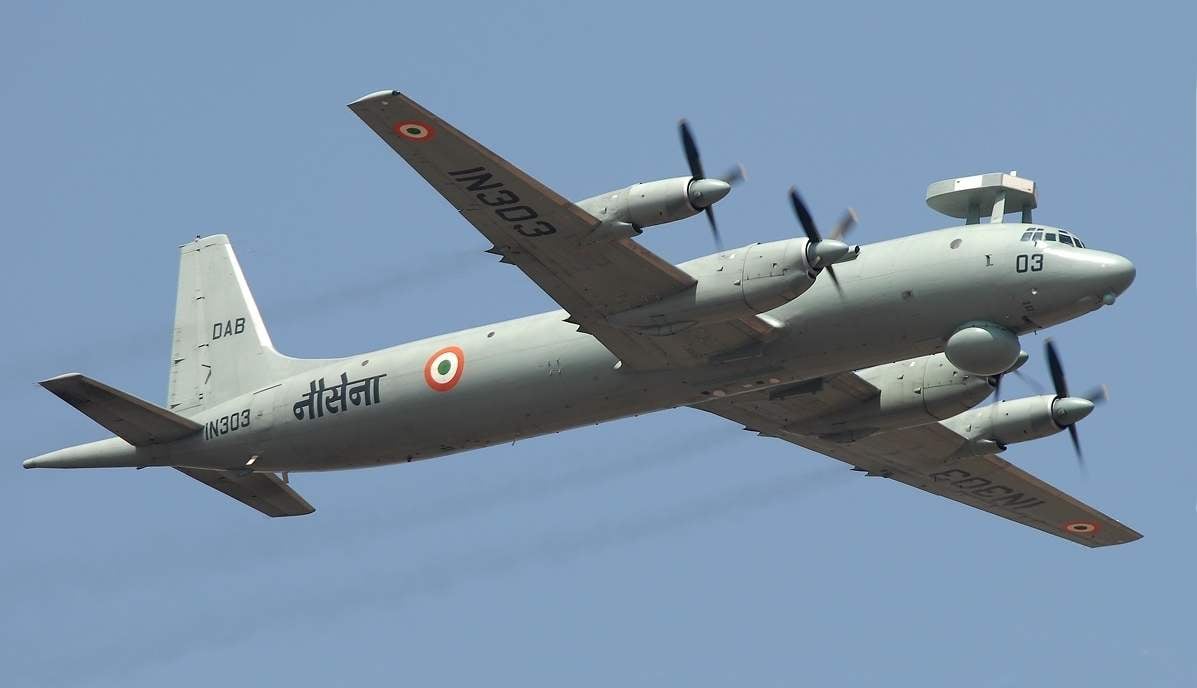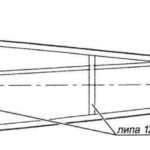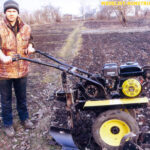In the rear fuselage have planned the placement of aeromagnetic APM-60 “Orsha”, which was the auxiliary means and serving only to confirm a contact with a submarine.
As follows from the Protocol of the mock-up Committee of the Il-38, anti-submarine warfare torpedoes were intended TAB-1 or tab-2, anti-aircraft missile APR-1 “Condor”, ten anti-submarine bombs PLAB-250-120 or PLAB-50, or up to 98 PLAB-MK. On Board the Il-38 can accommodate up to four minutes, IGDM (AMD-2M), APM, “Lira”, “Serpa” and RM-1 or up to eight, HDM-800 Total weight of discharged cargo reached 5620 kg.
In addition to semi-automatic tactical tasks, including the search for submarines with the production of sighting data and issue reset signals anti-submarine weapons, the system can provide automatic EN-route flight and semi-automatic — at other stages, except for takeoff and landing This contributed to the flight-navigation complex “Way-4B-2K,” the autopilot АП6Е and automatic radio ark-B.
Il-38, as compared to its predecessor, the passenger, reinforced chassis, updated de-icing and oxygen systems, as well as the device for the air conditioning Changed and the fuel system, while 30 300 liters of fuel was poured into the wing tanks (including tank caisson in the center section) and 4200 litres in the fuselage.
![Basic anti-submarine aircraft Il-38 with the staff of]()
Base anti-submarine aircraft Il-38 with the staff of “Berkut”:
1 — aerial route and glide-path landing systems, 2 — instrument compartment, 3,38 — front antenna Radiotechnika III range, the 4 — seat of the right pilot, 5 — seat flight engineer, 6 — chair 6ортрадиста, 7 — side seat, 8 — seat Navigator-radar operator; 9 equipment reception and information device “Orta”, 10 — instrument radar “eagle”, 11 — refrigeration unit, 12 — fuel tanks, 13 digital computing machine, the 14 — radio astronomy sextant, 15 units of equipment “RESEDA”, 16 and 22 — oxygen cylinders, 17 — cable the radio antenna HF range, 18 — liferaft PSN-2 and 19 units of equipment of the “Berkut”, the 20 — turbine generator T1 – 16, 21 battery, 23 — electro – and radio equipment, 24 — magnetosensitive unit “Orsha”, 25 — rear antenna Radiotechnika III range, 26 — tail safety support, 27 — unit meter Doppler ground speed and drift angle Wind, 28 antenna equipment “eagle”, 29 — torpedo PLAT-2,30 — wing center section, 31 — cassette buoys RSL-RSL buoy 1.32-3.33 to cover the entrance hatch to the pressurized cabin, 34 — mine, 35 — antenna radar unit “Berkut”, the 36 — radio-panel, 37 — antenna Radiotechnika; 39 receiver temperature N-1,40 receiver full pressure PPD-1,41,57,60 pulse light beacons media-2,42,48 — cover escape hatches, 43 antenna radio VHF-band, 44 — protective covering of the fuselage 45, the air intake of the air conditioning system hardware compartment, 46 — fairing of the outlet of the ventilation system of the fuselage; 47 window, 49 — cover liferaft ПСИ6А; 50 — exhaust hole TG-16, 51 — dorsal fin, 52 — Kiel, 53,122 — dischargers static electricity, 54 rudder 55 trimmer rudder, 56 — tail navigation light (red), 58 — radiotransparent Radome radar 59 — the transmitting station antenna system for short-range navigation RSBN-2C, 61 — antenna Radiotechnika, 62 — antenna stations of the system of short-range navigation RSBN-2S, 63,103 — landing-taxiing, 64 — a non-braking wheel 800×225 mm, 65 — protective reflective plate 66 and the cover entrance hatch, 67 — retractable gangway, 68 — brake wheel 900×285 mm, 69 — cover the charging port, 70 — arm, 71 — spinner; 72, the air intake ventilating the nacelle, 73 — removable cover nacelle to access the flame tube TMD AI-20M, 74,94 —blinds ventilation of the nacelle; 75 — fold adjustable tunnel cooler TVD; 76, the air intake inlet tunnel massardier theater; 77 — upper thrust compensation mechanism, 78 — strut 79 — side brace, 80 — lock the retracted position the main landing gear, the 81 — slot-hinge; 82 — stabilizing damper truck; 83 — clip lock the retracted position the main bearing, 84 — lower thrust compensation mechanism, the 85 — truck chassis; 86 — the lock released position of main landing gear, 87 — hydraulic cylinder-lift; 88 — clip of the castle retracted position of the front support, 89 — cylinder, 90 — lock the retracted position of the front landing gear, 91 — strut 92 — the lock released position of the front support, 93 — side brace, a 95 air intake cooling of the generator, 96 — fairing centrifugal breather, 97, the air intake for ventilation of the engine compartment 98, the hydraulic cylinder turning the front wheels, 99 — electrothermal de-icing system blade propeller AV-68, 100 — air intake TVD AI-20M, 101 — centroplane panel thermoelectric anti-icing system, 102 — propeller variable-pitch AV-68, 104 — dvuhmetrovoe deflector flap; 105 — hydraulic cylinder-lift, 106 — rear right wing navigation light (green) 107 front right wing navigation light (green); 108 — fold front landing gear, 109 — cone stub antenna, automatic radio compass, ark-B, 110 — fold hatch front gruzootseke; 111 cassette signal cartridges EXP-39; 112 — fold niche of the front landing gear; 113 — radio-bar loop antenna, automatic direction finder ark-B, 114 —stabilizer, 115 — steering wheel height 116 — trimmer of the Elevator, 117 — radio-panel antennas measuring the Doppler ground speed and drift angle, 118 — fold rear hatch gruzootseke, 119 —double slit flap, 120 — trimmer Aileron, 121 — Aileron, 123 — middle fold niches main landing gear, 124 — fold struts in the front 125 — rear Assembly niches main landing gear
The original Il-38 were calculated under the AI-20 engines, with which the takeoff weight does not exceed 63 500 kg Prototype built at the pilot plant OKB-240 in conjunction with the plant number 30, put the finished assemblies of the airframe and some systems.
September 27 1961 the first flight of the Il-38 turboprop engine, AI-20, but without anti-submarine equipment (crew — test pilot V. K. Kokkinaki, the co-pilot e And Kuznetsov, Navigator In f resurrection, the radio operator And Eliminou) Leading testing was an engineer With M. Goldmann and the pilot And M. Turunen In may next year, the customer showed a layout (actually a finished aircraft models with anti-submarine equipment). The mock-up Commission was headed by I. Borzov.
In September 1962, flew the second prototype of the Il-38 Installation on the machine equipment “eagle” combined with the navigation system using the tsvm-264, completed only 16 Mar 1963, and later a fully equipped machine started in April of next year. In August, after the completion of the first phase “A” of state tests, it became clear that all aircraft systems and avionics, including search and sighting station “Berkut” brought to a healthy state, and their parameters correspond to the tactical and technical requirements.
A month later, the second phase of joint state tests, but from December until April 1965 had to take a break, associated with the replacement of the equipment, is exhausted, install a new more powerful engine AI-20M and the elimination of identified defects state Tests Il-38 was completed in 1968 Serial production of the Il-38 is carried out at the factory number 30 in Moscow. The first production aircraft with engines AI-20M soared in September 1967, and on 17 January 1969 the car has adopted a Construction of the Il-38 was completed in February 1972 with the release of 58 machines, five of which were sold to the Indian Navy the Use of more powerful engines in comparison with the prototype, increased the maximum takeoff weight of machine 2500 kg, and the “commercial” load of 8000 kg, the flight duration was 16 h. In this case the tactical range was 2,200 km and the duration is patrolling in a given area was 3 to 3.5 h.
Exploitation of Il-38 in the Navy began in late 1968 the First aircraft mastered the crews of aircraft of the Northern fleet.
While the car was tested and organized serial production, in its Arsenal appeared guided bombs KAB-500ПЛ with acoustic guidance system. Adopted and the newest missile-torpedo “Orlan”. Aeromagnetic AP-60 replaced by the AP-73 Then the round Radome of the radar system “Berkut” gave a teardrop shape.
In 1970 the Il-38 has mastered the aviators of the Pacific fleet (TOF). In the spring of the same year, these aircraft participated in the large-scale maneuvers “Ocean”. Three years later the Il-38 appeared in the Baltic fleet.
In the initial period of development the Il-38 main tactics of search of submarines was only “barrier”, when the estimated path of submarines exposed the barriers of sonobuoys In the early 1970s, has developed another, more effective method for finding enemy submarines by placement of buoys throughout the area of their intended location, added the “barrier” tactic This has required changes not only in the software of onboard digital computer, but also placing on Board the aircraft of additional equipment, in particular, the automatic navigation device, ANP-38, to improve the accuracy of maneuvering while tracking underwater objects of the enemy.
В1972 g tested method of flying the Il-38 on three and two engines in-Flight research has confirmed the possibility of increasing the duration of the flight on two engines But further experiments did not get Probably, the command of naval aviation itself, insure, pursuant to rule, as if something had happened.
In September 1983 Il-38 was attracted to search for the remains passenger aircraft “Boeing-747” KAL South Korean airline that crashed in the sea of Okhotsk In 1989, anti-aircraft assistance to the crew who have suffered a disaster of the submarine “Komsomolets”.
First the car was lost in December 1987 in the Pacific fleet. That day the commander of the ship Vladimir N. Koshkin thought that the aircraft accelerated slowly, and he decided to stop off, when the needle of the speed indicator showed 250 km/h Heavy car, despite the emergency brake, skidded off the runway and got so severely damaged that it had to be written off.
Happened and the tragedy, February 3, 1994 during approach to landing in adverse weather conditions the Il-38 aircraft of the Northern fleet touched the wing of the ground and crashed, killing seven crew members.
In 1995, the Russian delegation to the Il-38 for the first time officially visited the US air base, Elmendorf (AK), and the next summer the aircraft ASW became a member of the international aviation exhibition held on the Royal air force of great Britain Fafard.
April 15, 1999 during a patrol flight Il-38 crew commander of the squadron In zemlyanova found off the coast of Kamchatka foreign nuclear submarine (in one of the discarded sonobuoys suddenly gave the signal serifs submarines) Optionally reset the buoys allowed us to classify the object and identifying in it the boat type “Los Angeles”, to determine the nature of its movement After the report to the Navy yard the crew followed the enemy about a half hour then work onboard radar in active mode, with the permission of the command given to understand “the guest”, what she discovered and its presence near the Russian coast is not desirable.
The last peaceful operation of the Il-38 was the search for the crew of the ship Sinegorye, which sank in October 2006 the Korean coast, Then the crew of antisubmarine aircraft found the bodies of two of our sailors.
But time goes on and the aircraft is physically and morally obsolete the First attempts of modernization of the aircraft variant of the Il-38M refer to the beginning of the 1970s, when it was equipped with the device in-flight refueling aerial Refueling was carried out from the same modified Il-38М3, equipped with a universal refueling unit ORM-38, radio engineering system of short-range navigation RSBN-20V to search for and meeting of aircraft in the refueling and extra fuel tanks in its cargo compartments. State tests of the improved machine was completed in may 1977, but adopted and not adopted.
After more than 20 years on the modernization of Il-38 began to talk again, especially about replacing PPS “Berkut” system “the short story” the New facility is fully digital, has a smaller mass and dimensions for large opportunities.
“Novella” includes radar, television-thermal imaging engine and infrared sensor (no Il-38), a sonobuoys system, a magnetometer and a system of electronic surveillance is Planned to equip the new aircraft defense system, including the station warning receiver, infrared sensor detect start and approaching missiles, the jammer device shooting traps On the Il-38 will be replaced navigational and radio equipment.
As already noted, the sole importer of the Il-38 was India, which bought five cars appearance in the late 1990-ies PPS fifth generation “novel” helped to improve and expand the functionality of the Il-38. Getting to the modernization of the aircraft variant of the Il-38N, AK named after S. Ilyushin In not limited to the replacement of the teaching staff and have updated almost all the members of electronic, proteininteractions and other equipment, adding new, previously unused system the Aircraft is also equipped with thermal imaging, television and laser equipment, allowing greater accuracy to detect and identify both surface and underwater targets Appeared on Board the Il-38N and equipment, electronic reconnaissance, mounted in the container above the fuselage In the end, the plane was purchased and a new look.
Variant of the Il-38N to 2010 is expected to upgrade all domestic cars with extension of service life to 45 years.
The first stage of conversion of the Il-38 to Il-38N was completed in the spring of 2001, and in the same year it began its flight tests.
After the completion of state tests is expected to 2015, to upgrade more than half of in service aircraft of the Russian Navy Il-38 Test Il-38N was held so well that to the “Rosoboronexport” signed a contract with the Indian Navy about upgrading five Il-38SD with the installation of the export version of the PPP “Novella”, called “Sea snakes”.
“Sea serpent” is able to simultaneously track more than 30 targets (ships, submarines, and naval mines and aerial targets), the system can be connected to the satellite navigation system GLONASS. Revised and armament of the aircraft, entering into its composition, in particular anti-ship missiles KH-35E.
October 1, 2002 in the Indian state of Gras the tragedy occurred When performing demonstration flights faced two Il-38, killing 12 crew members. Despite this, the Indian military decided the remaining three machines upgraded variant of the Il-38SD, which will be equipped with supersonic anti-ship missiles “BrahMos”.
The basic data of the aircraft Il-38
Engines type…………………………AI-20M
Take-off power, HP………….4×4250
Wing span, m……………………..37,4
Length, m………………………………..40,75
Height in the Parking lot, m……………..10,165
Wing area, m………………….140
Takeoff weight, kg…………………66 000
Empty weight, kg……………………34 000
Payload weight, kg……….8000
Fuel capacity, l……………………34 500
Cruising speed, km/h…….580 600
Practical ceiling, m………..10 000
Maximum range, km….8500
The duration of the flight, h…9
 Antisubmarine warfare in the postwar years in the Soviet Union has always paid great attention. This goal was created not only surface ships, but also planes, it is Sufficient to recall the seaplane Be-unmanned, equipped with sonobuoys buoys, aeromagnetic, anti-submarine bombs and mines. With the advent of U.S. nuclear submarines armed with ballistic missiles “Polaris”, significantly increased the role of anti-submarine aircraft, which is now required not only discovery and destruction of submarines of the enemy, but also constant monitoring of their movements in the waters of the World ocean, the clarification of the anticipated areas of their combat duty Be-6, as established later, the amphibian be-12, were not suitable for patrolling in the remote areas of the oceans, and established on them equipment is not allowed to solve such a complex task.
Antisubmarine warfare in the postwar years in the Soviet Union has always paid great attention. This goal was created not only surface ships, but also planes, it is Sufficient to recall the seaplane Be-unmanned, equipped with sonobuoys buoys, aeromagnetic, anti-submarine bombs and mines. With the advent of U.S. nuclear submarines armed with ballistic missiles “Polaris”, significantly increased the role of anti-submarine aircraft, which is now required not only discovery and destruction of submarines of the enemy, but also constant monitoring of their movements in the waters of the World ocean, the clarification of the anticipated areas of their combat duty Be-6, as established later, the amphibian be-12, were not suitable for patrolling in the remote areas of the oceans, and established on them equipment is not allowed to solve such a complex task.






